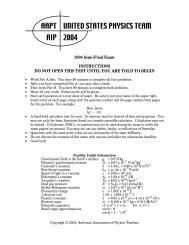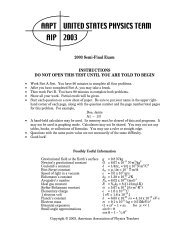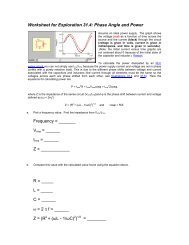Worksheet for Exploration 35.2 - comPADRE
Worksheet for Exploration 35.2 - comPADRE
Worksheet for Exploration 35.2 - comPADRE
You also want an ePaper? Increase the reach of your titles
YUMPU automatically turns print PDFs into web optimized ePapers that Google loves.
<strong>Worksheet</strong> <strong>for</strong> <strong>Exploration</strong> <strong>35.2</strong>: Ray Diagrams<br />
You will often use ray diagrams in order to<br />
determine where an image of an object will be,<br />
whether it will be real or virtual, and whether it<br />
will be inverted or upright (position is given in<br />
meters). The animation shows an object arrow,<br />
a lens, and pink dots to show the focal point of<br />
the lens. Restart.<br />
a. Two point sources are attached to the object in the animation. Move the object and notice where the<br />
rays from the point sources converge. In order to sketch a diagram of the object, the lens and the<br />
approximate position of the image, you need to know where the light from these sources (from the<br />
object) converges. As you move the object around, what do you notice about the rays that are parallel<br />
to the principal axis (either be<strong>for</strong>e entering the lens or after leaving the lens)<br />
Why do they always cross the axis at the same place<br />
b. Instead of trying to draw a large number of the rays from many points on the object, we generally use<br />
three rays from the tip of the object (sometimes called principal rays) to sketch a ray diagram. Change<br />
to the "ray diagram" view. Describe the three rays (compare them to the list in your textbook, if<br />
needed).<br />
Which one goes from the object through the lens and then through the focal point
Which one seems to be undeflected as it goes through the lens<br />
Which one goes through the focal point (on the object side) and then through the lens<br />
c. Look at a diverging lens with a point source. Try sketching a ray diagram <strong>for</strong> a diverging lens. Check it<br />
by looking at the ray diagram.

















